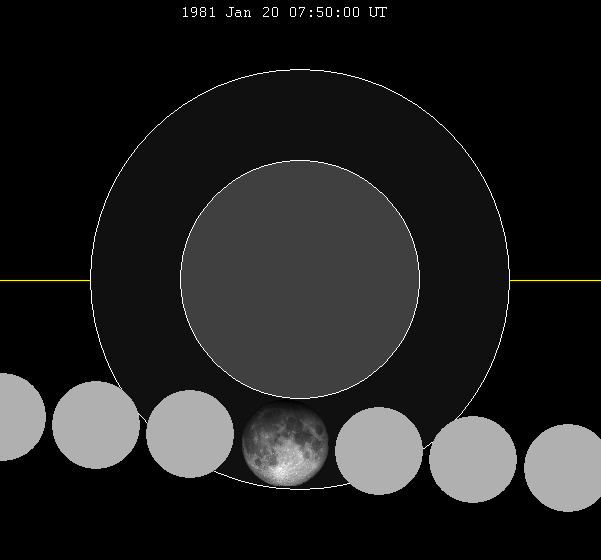January 1981 Lunar Eclipse on:
[Wikipedia]
[Google]
[Amazon]
A penumbral


lunar eclipse
A lunar eclipse occurs when the Moon moves into the Earth's shadow. Such alignment occurs during an eclipse season, approximately every six months, during the full moon phase, when the Moon's orbital plane is closest to the plane of the Eart ...
took place on Tuesday, January 20, 1981, the first of two lunar eclipses in 1981. In a rare total penumbral eclipse, the entire Moon was partially shaded by the Earth (though none of it was in complete shadow), and the shading across the Moon should have been quite visible at maximum eclipse. The penumbral phase lasted for 4 hours and 24 minutes in all, though for most of it, the eclipse was extremely difficult or impossible to see. The moon's apparent diameter was larger because the eclipse occurred 5.2 days after perigee (Perigee on approximately 1981 Jan 15 at 03:01:56.7 UTC).
This was a relatively rare total penumbral lunar eclipse
A total penumbral lunar eclipse is a lunar eclipse that occurs when the Moon becomes completely immersed in the penumbral cone of the Earth without touching the umbra.
The path for the Moon to pass within the penumbra and outside the umbra is ve ...
with the moon passing entirely within the penumbral shadow without entering the darker umbral shadow.
More details about the Penumbral Lunar Eclipse of 1981 Jan 20.
Penumbral Magnitude = 1.01360 Umbral Magnitude = -0.01916 Gamma = -1.01421 Sun Right Ascension = 20.16 Sun Declination = -20.1 Sun Diameter: 1950.4 arc-seconds (32'30.4") Moon Right Ascension = 8.15 Moon Declination = 19.1 Moon Diameter = 1888.6 arc-seconds (31'28.6") Earth's Shadow Right Ascension: 8.16 Earth's Shadow Declination: 20.1 Earth's Shadow Diameter: 8,968.32 arc-seconds (2.4912 degrees) Greatest Eclipse: Tuesday, 20 January 1981 at 07:49:56.7 UTC Saros Series = 114th (57 of 71)Visibility


Related lunar eclipses
Eclipses in 1981
* A penumbral lunar eclipse on Tuesday, 20 January 1981. * An annular solar eclipse on Wednesday, 4 February 1981. * A partial lunar eclipse on Friday, 17 July 1981. * A total solar eclipse on Friday, 31 July 1981.Lunar year series
Saros series
Lunar Saros series 114, repeating every 18 years and 11 days, has a total of 71 lunar eclipse events including 13 total lunar eclipses. First Penumbral Lunar Eclipse: 0971 May 13 First Partial Lunar Eclipse: 1115 Aug 07 First Total Lunar Eclipse: 1458 Feb 28 First Central Lunar Eclipse: 1530 Apr 12 Greatest Eclipse of Lunar Saros 114: 1584 May 24 Last Central Lunar Eclipse: 1638 Jun 26 Last Total Lunar Eclipse: 1674 Jul 17 Last Partial Lunar Eclipse: 1890 Nov 26 Last Penumbral Lunar Eclipse: 2233 Jun 22Half-Saros cycle
A lunar eclipse will be preceded and followed by solar eclipses by 9 years and 5.5 days (a half saros).Mathematical Astronomy Morsels, Jean Meeus, p.110, Chapter 18, ''The half-saros'' This lunar eclipse is related to two annular solar eclipses ofSolar Saros 121
Saros cycle series 121 for solar eclipses occurs at the Moon's ascending node, repeating every 18 years, 11 days, contains 71 solar eclipse events. 55 of these are umbral eclipses. All eclipses in this series occurs at the Moon's ascending node. ...
.
See also
*List of lunar eclipses
There are several lists of lunar eclipses
On the Moon, by the Earth
; Type
* List of central lunar eclipses
* Total penumbral lunar eclipse
A total penumbral lunar eclipse is a lunar eclipse that occurs when the Moon becomes completely immersed ...
*List of 20th-century lunar eclipses
A total of 229 lunar eclipses took place in the 20th century: 83 penumbral, 65 partial and 81 total.
See also: Lists of lunar eclipses, List of 19th-century lunar eclipses and List of 21st-century lunar eclipses
List
Eclipses from 2001 to ...
Notes
External links
* 1981-01 1981-01 1981 in science January 1981 events {{lunar-eclipse-stub